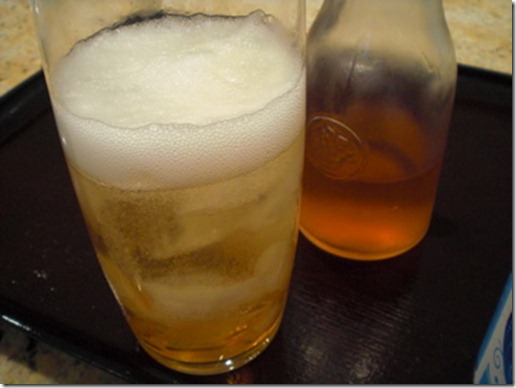Kon-nyaku. 蒟蒻, some times spelled “
konjac ”, and called “Devil’s tongue” in English, is a rather peculiar food item made out of the starch extracted from a particular vegetable root. It has the consistency of hard jelly and practically no taste and no calories. Japanese traditionally use it as an
oden おでん item. I have posted a
few dishes using konnyaku. This is another konnyaku dish but, with the deep frying it loses its no calorie status. You do not find this type of dish anywhere but at an Izakaya.

I made two different versions which mostly provide differences in texture rather than taste. I served this dish on a funky triangular shaped plate on which a folded “tempura shikishi 天婦羅敷き紙 paper fits perfectly. I garnished it with deep fried and crispy parsley and sprinkled single flavored Japanese red pepper flakes or “Ichimi tougarashi” 一味唐辛子.
 Preparation of konnyaku
Preparation of konnyaku: I first washed and drained one cake of konnyaku (#1 below). To make two versions, I first divided one cake into two equal portions. For one half, I halved the thickness by slicing horizontally as I pressed down using my palm flat on the surface of the konnyaku. I then applied a series of shallow cuts obliquely in one direction, turned it around and added another series of cuts perpendicular to the previous cuts (#2 below). I then turned the pieces over and did the same cuts on the other side. You need to be careful not to cut through. I then cut it into I inch wide strips (#3 below). The other half of konnyaku, I just cut into 1 x 1.5 inch rectangles and poked multiple holes using a fork (#4 below). The idea here is to change the texture of knonyaku as well as make it absorb the marinades (see below) better. After this preparation, I placed the konnyaku pieces in a pot with amplen a amount of water on medium flame. I allowed it to come to the boil and cooked it for 2-3 minutes. I then drained and washed it in running cold water. This process removed a the peculiar (and rather unpleasant) smell characteristic of konnyaku.
 Marinades
Marinades: I made two marinades. Since no matter how you do it, konnyaku will not absorb marinades or any seasoning easily, I use undiluted soy sauce; one with grated ginger and one with yuzu-koshou. The amounts are again arbitrary but I used about 4 tbs soy sauce and 1/2 tsp each of grated ginger or yuzu-koshou. I marinated the cross hatched ones with the ginger and the rectangular ones with the yuzu koshou. I ended up marinating this for two days in the refrigerator for reasons beyond my control. Ordinarily just a few hours of marination would suffice. There is no worry of over marinating since the konnyak itself does not absorb, instead, the marinades are held in the holes and crevices I created in the konnyaku.
Just before frying, I took the konnyaku pieces out of the marinades and blotted the surface with a paper towel but did not squeeze out the absorbed marinades. I then dredged in potato starch or katakuriko 片栗粉.
Deep frying: I put peanut oil in a frying pan to the depth of about 1 inch on a medium flame. When the oil was 170C (325F), I deep fried the konnyaku pieces for 3 minutes or until the surface got crispy.
I served this piping hot with a sprinkling of one flavor Japanese red pepper flakes 一味唐辛子. The marinades provide enough saltiness and I did not serve this with any dipping sauce. The difference between the two marinades was very subtle but the yuzu-koshou version added more heat and a citrus note. Although it was not bad—how can anything deep fried be bad, we quickly dispatched the entire dish between two of us. Considering the rather tedious preparation and the fact this is “deep fried”, we are not sure if this dish is worth making often. We prefer a simpler dish such as
spicy konnyaku stir fry I made previously.
















